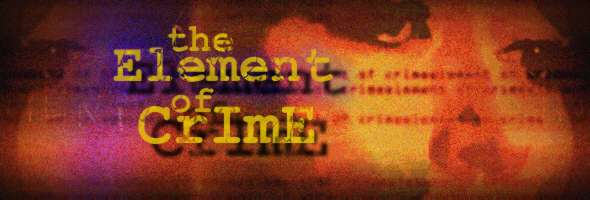
Color, 1984, 104m.
Directed by Lars von Trier
Starring Michael Elphick, Me Me Lai
Criterion (US R1 NTSC) / WS (1.85:1) (16:9)
Long before he became one of the great modern enfants terribles of filmmaking with Antichrist, Breaking the Waves, and Nymphomaniac, Danish director Lars von Trier already had talent to burn in his first film, The Element of Crime (or Forbrydelsens element in its native country). Like most of his films, this is definitely a love it or hate it project, with a visually dazzling appearance and deliberately sluggish pace which will leave uninitiated viewers begging for mercy after 15 minutes. For those who like von Trier or edgy world cinema, The Element of Crime is required viewing, but others definitely will want to rent before they buy.
Seasoned, world-weary retired cop Fisher (Michael Elphick) sits beneath the unsettling gaze of an obese, foreign therapist (Ahmed El Shenawi), who uses hypnosis to coerce Fisher into relating the horrific tale of what happened to him in Europe. Told in flashbacks with constant voiceovers, the story follows Fisher from his complacent residence in Cario to his old stomping grounds in a postapocalyptic Germany, where some unnamed disaster has left the world bathed in perpetual darkness and drenched in polluted, shimmering lakes. Fisher consults an esteemed criminologist and former detective, Osborne (Esmond Knight), who has written a detailed procedural work called The Element of Crime. According to the book, a detective can retrace a killer's steps and, by inhabiting the criminal's environment, discover everything he needs to know about the culprit. Fisher decides to use the book as his model for hunting down Harry Gray, the primary suspect in a gruesome series of slayings dubbed "The Lotto Murders," because the victims were all young female lottery ticket sellers who wound up strangled and disfigured with broken bottles. Fisher begins at the site of the first murder and works his way through the seedy local populace, encountering surreal characters and visual tableaux along the way. He hooks up with a prostitute named Kim (Me Me Lai, the star of Jungle Holocaust and Man from Deep River!) and takes her along on his journey, stopping occasionally to have sex with her in hotel rooms and atop Volkswagens. ("I'm going to screw you back to the Stone Age," he charmingly claims at one point, to which she later adds, "I want you to screw God into me.") Fisher feels himself closing in on his prey, but he soon comes to fear that his own soul may be disintegrating in his quest for the truth about the criminal mind.
While the plotline isn't much more than a retread of Thomas Harris' Red Dragon by way of Blade Runner postmodern film noir, von Trier's astounding visual sense turns the most mundane scenes into fascinating, multi-layered visuals. His most brilliant moments find the camera trailing over characters dangling near the edge of an abyss, as when Fisher languishes in a drunken haze by a stone precipice or Kim lies beneath an arrangement of glowing yellow lights. In fact, most of the film stock was manipulated into a hellish sepia tone, rendering unnatural shades of gold and orange over every scene except for occasional dramatic interruptions of electric blue (usually lightbulbs or TV screens) or, more rarely, red. This technique could have been a childish stunt, but it works beautifully here and produces a sense of unease that never lets up. In a sense this feels like a dry run for his third film, the masterful Europa (or as Miramax christened it in the US, Zentropa), which also opens with the audience being lulled into hypnosis and sports a lab-manipulated use of monochromatic footage alternating with color. Sharp-eyed viewers should also look for a cameo by von Trier as a skinhead hotel clerk referred to by Fisher as the "Schmuck of Ages."
Apart from scarce arthouse screenings, for over a decade most viewers could only see The Element of Crime in a horribly muddy, cropped VHS edition from Unicorn. The Criterion edition looks infinitely better, and what was most likely a transfer technician's nightmare has resulted in a beautifully nuanced image with appropriately rich and black shadows. Don't panic when the film comes on; it really is supposed to look that way, and the film's look obviously influenced such later films as The City of Lost Children and pretty much everything by David Fincher. The mono soundtrack is fine, though the English dialogue can get muddy thanks to the international cast and oppressive sound mix. Thankfully Criterion has included optional English subtitles, which will come in handy throughout the film. The disc also includes the original European trailer, which blows several key moments late in the film, and a terrific 54 minute documentary, Stig Björkman's “Tranceformer: A Portrait of Lars von Trier,” which features in depth interviews with von Trier and his longtime collaborators. From early family home movies to short film projects to his features up to Breaking the Waves, this is everything you could want to know about the controversial filmmaker. Especially interesting are mint quality clips from the rarely seen Epidemic, his second film, and some great behind the scenes footage from Breaking the Waves. (Funniest moment: Jean-Marc Barr's observation before shooting his shower stall scene with a naked Stellan Skarsgård.) There may not be a particularly groundbreaking message by the time it's all done, but at least you get a thorough, sometimes contradictory portrait of a cinematic voice that cannot be ignored.
![]()